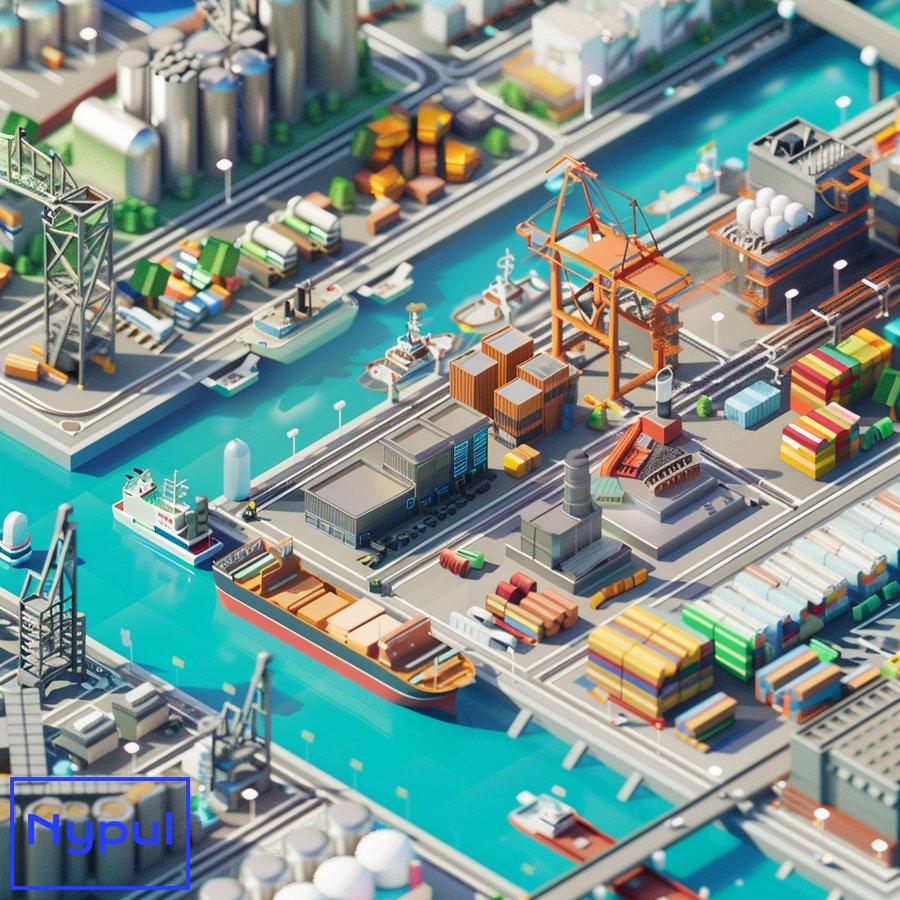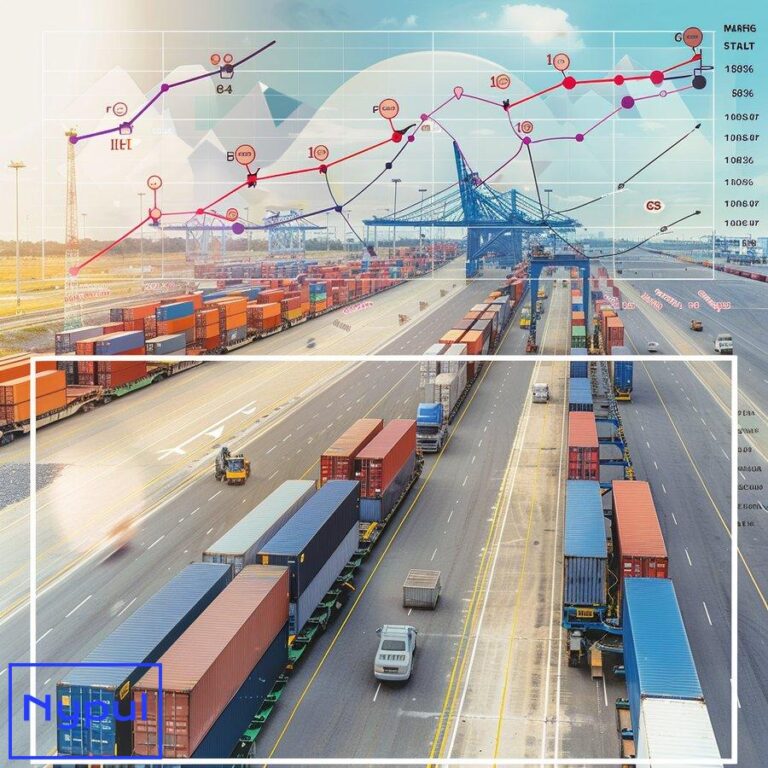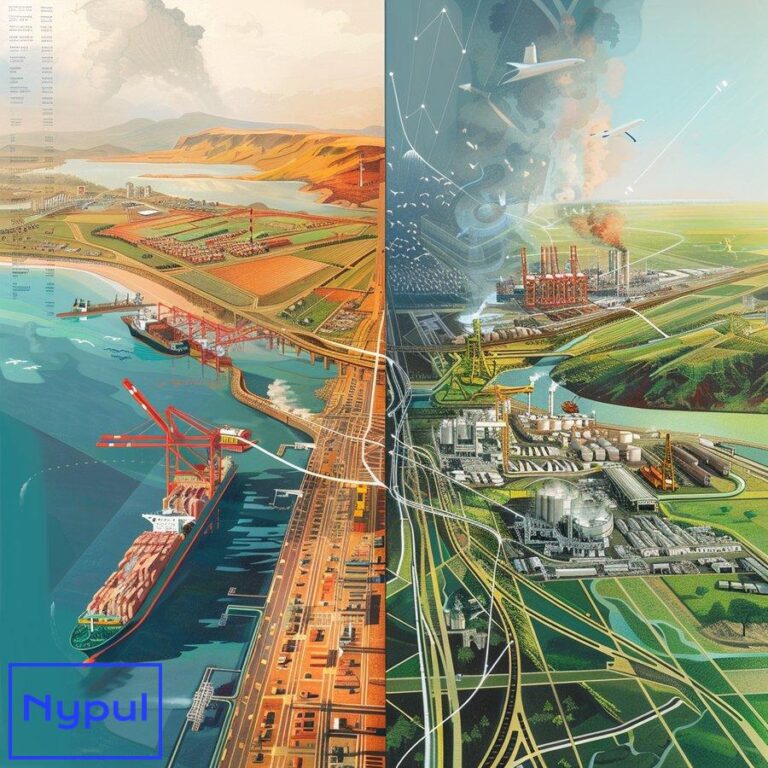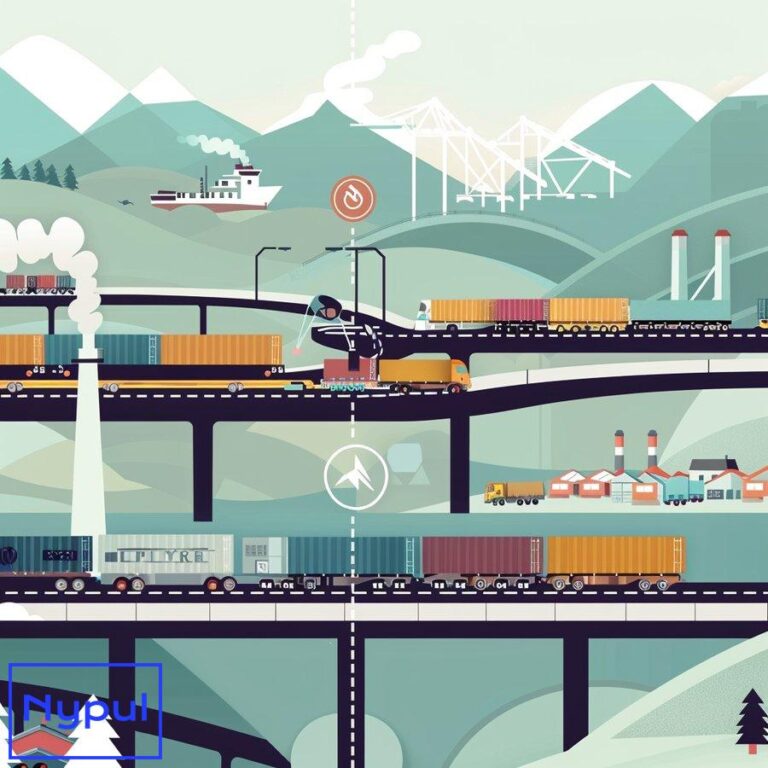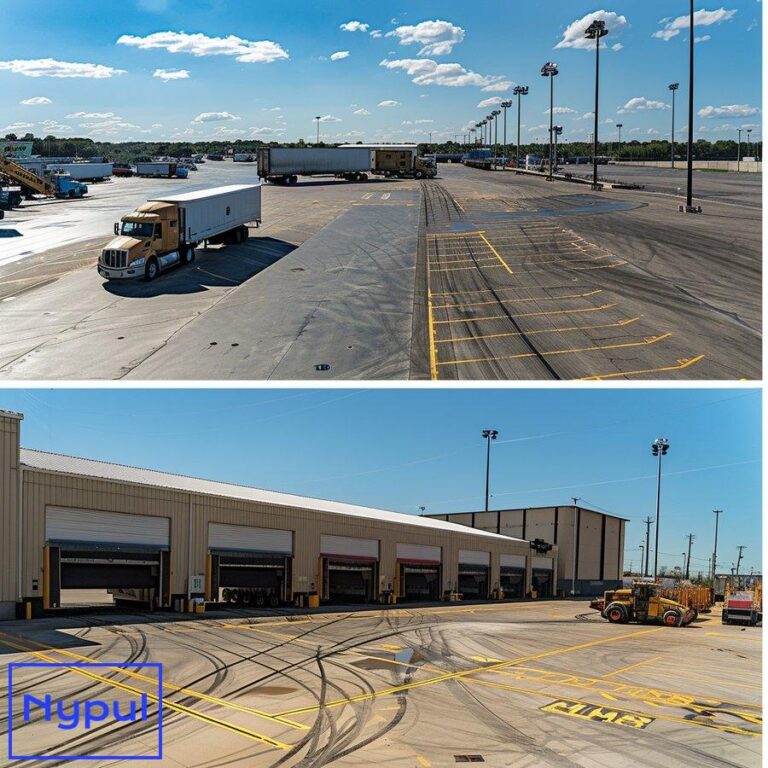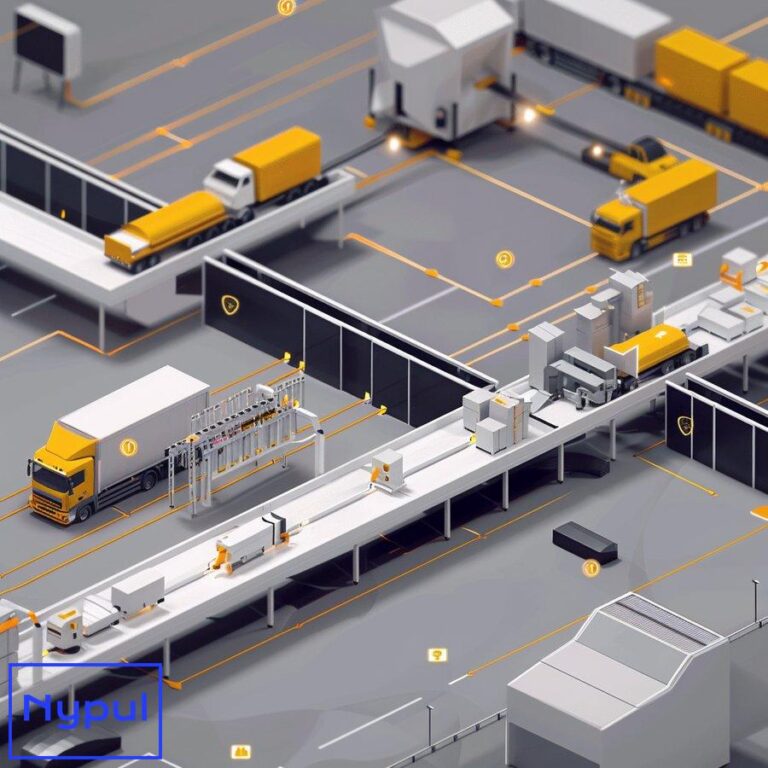What Is Drayage in International Trade
Why is drayage crucial for global supply chains?

Drayage forms a critical link in global supply chains, connecting ports, rail yards, and distribution centers to enable the seamless flow of goods across international borders. As the first and last mile of intermodal freight transportation, drayage bridges the gap between long-distance shipping and local delivery.
The importance of drayage in global trade stems from its role in:
Facilitating modal transfers
Drayage allows cargo to transition between different transportation modes like ships, trains, and trucks. Without efficient drayage, containers would pile up at ports and rail terminals, causing costly delays and disruptions.
Enabling just-in-time logistics
By providing flexible, short-distance transportation, drayage supports lean inventory practices and just-in-time manufacturing. Companies can quickly move goods from ports to nearby warehouses or production facilities as needed.
Reducing congestion at ports
Prompt drayage operations prevent bottlenecks at busy seaports by swiftly moving containers out of terminal yards. This improves overall port productivity and capacity.
Supporting e-commerce fulfillment
As online retail grows, drayage plays a key role in transporting imported goods from ports to regional distribution centers for rapid order fulfillment and delivery.
Enhancing supply chain visibility
Modern drayage providers offer real-time tracking and status updates, giving shippers greater visibility into the movement of their cargo during a critical phase of transport.
Optimizing container utilization
Efficient drayage allows for faster turnaround of shipping containers, maximizing their productive use and reducing equipment shortages.
The strategic value of drayage becomes evident when examining its impact on key supply chain metrics:
| Metric | Impact of Efficient Drayage |
|---|---|
| Lead times | Reduced by 1-3 days on average |
| Inventory costs | Lowered by 5-10% through improved JIT capabilities |
| Port congestion | Decreased by 15-25% with faster container movements |
| Container dwell times | Cut by 30-50% at terminals |
| Supply chain visibility | Enhanced with real-time tracking and status updates |
As global trade volumes continue to grow, the strategic importance of drayage in supply chains is only expected to increase. Companies that optimize their drayage operations gain a competitive edge through improved efficiency, reduced costs, and enhanced customer service.
What are the different types of drayage services in international commerce?
In international commerce, drayage services come in various forms to meet the diverse needs of shippers and logistics providers. Understanding these different types helps businesses choose the most appropriate drayage solution for their specific requirements.
Inter-carrier drayage
This involves moving cargo between different transportation carriers. For example, transferring a container from a shipping line to a rail company at a port. Inter-carrier drayage ensures smooth transitions between modes of transport in intermodal shipping.
Intra-carrier drayage
This type of drayage occurs when cargo is moved between facilities owned by the same carrier. It might involve relocating containers between different terminals or depots operated by a single shipping line or logistics provider.
Expedited drayage
When time is of the essence, expedited drayage provides rapid transportation of urgent shipments. This service often involves dedicated trucks and priority handling to ensure the fastest possible delivery.
Pier drayage
Specifically focused on moving containers to and from port facilities, pier drayage is crucial for import and export operations. It connects seaports with inland transportation networks.
Shuttle drayage
This service involves short, repetitive movements between two nearby locations, such as between a port and a nearby warehouse or distribution center. Shuttle drayage optimizes the flow of goods in high-volume corridors.
Door-to-door drayage
A comprehensive service that handles the entire journey from the origin point (e.g., a factory) to the final destination (e.g., a retail store). This end-to-end solution simplifies logistics management for shippers.
Cross-town drayage
Involves moving cargo across a metropolitan area, often between different terminals or logistics hubs. This service is vital for efficient urban freight distribution.
Bonded drayage
Used for transporting goods that have not yet cleared customs. Bonded drayage providers are authorized to move cargo under customs bond, ensuring compliance with import regulations.
The choice of drayage service depends on various factors:
Cargo type
Different drayage services are suited for various types of cargo, from standard containers to oversized or specialized freight.
Distance
The length of the haul influences the type of drayage service required, ranging from short pier drayage to longer cross-town movements.
Time sensitivity
Urgent shipments may require expedited drayage services to meet tight deadlines.
Customs status
Goods that have not cleared customs require bonded drayage services to ensure regulatory compliance.
Volume and frequency
High-volume, regular shipments might benefit from dedicated shuttle drayage services.
To illustrate the application of different drayage types, consider the following scenarios:
| Scenario | Drayage Type | Benefit |
|---|---|---|
| Urgent medical supplies arriving at a port | Expedited drayage | Rapid delivery to hospitals |
| Regular container flows between port and nearby DC | Shuttle drayage | Optimized, high-frequency movements |
| Imported goods awaiting customs clearance | Bonded drayage | Compliant movement of uncleared cargo |
| Container transfer from ship to rail | Inter-carrier drayage | Seamless intermodal connectivity |
| Moving containers between terminals of same shipping line | Intra-carrier drayage | Efficient fleet and equipment management |
By understanding and leveraging these various drayage services, businesses can create more efficient, flexible, and responsive supply chains in international commerce. The right drayage strategy can lead to significant improvements in transit times, cost-effectiveness, and overall logistics performance.
How do drayage operations work in practice?
Drayage operations involve a series of coordinated steps to move cargo efficiently over short distances, typically within a metropolitan area. Understanding this process is crucial for businesses engaged in international trade to optimize their supply chain operations.
Pre-arrival planning
Before a ship docks or a train arrives, drayage providers receive advance notifications about incoming cargo. This information includes details such as container numbers, cargo types, and expected arrival times. Drayage companies use this data to plan their operations, allocate resources, and schedule pickups.
Terminal procedures
Once the cargo arrives at the port or rail terminal, several steps occur:
Container discharge
Containers are unloaded from the vessel or train using specialized equipment like gantry cranes.
Customs clearance
For international shipments, customs officials may inspect the cargo and process necessary documentation.
Container release
After clearance, the terminal releases the container for pickup by the drayage provider.
Drayage pickup
The drayage process begins in earnest when the truck arrives at the terminal:
Driver check-in
The drayage truck driver presents credentials and pickup information at the terminal gate.
Container location
Terminal staff direct the driver to the specific location of the container within the yard.
Container loading
Using terminal equipment or the truck’s own capabilities, the container is loaded onto the drayage vehicle.
Transportation
The core of drayage operations involves the actual movement of the container:
Route planning
Drivers follow optimized routes to navigate urban traffic and reach the destination efficiently.
Real-time tracking
Many drayage providers offer GPS tracking, allowing customers to monitor their cargo’s progress.
Delivery and unloading
Upon reaching the destination (e.g., a warehouse or distribution center), the container is unloaded:
Arrival notification
The driver alerts the receiving facility of their arrival.
Container placement
The container is positioned for unloading, either by removing it from the truck or placing the entire trailer for live unloading.
Documentation
Necessary paperwork is completed to confirm delivery and transfer responsibility for the cargo.
Empty container management
After unloading, the empty container must be handled:
Return to terminal
Empty containers are often returned to the port or rail terminal for reuse.
Repositioning
Sometimes, empty containers are moved to other locations where they are needed for export loads.
Equipment maintenance
Drayage providers must maintain their fleet and equipment:
Truck servicing
Regular maintenance ensures vehicles are road-worthy and efficient.
Chassis management
Proper inventory and maintenance of container chassis is crucial for smooth operations.
To illustrate the efficiency of well-executed drayage operations, consider the following performance metrics:
| Operational Step | Average Time | Potential Improvement with Optimization |
|---|---|---|
| Terminal pickup | 60-90 minutes | 30-45 minutes with pre-arrival planning |
| Urban transport (20 miles) | 45-60 minutes | 30-45 minutes with route optimization |
| Warehouse delivery | 30-45 minutes | 20-30 minutes with appointment scheduling |
| Empty return | 45-60 minutes | 30-45 minutes with coordinated repositioning |
Effective drayage operations require seamless coordination between various stakeholders, including shipping lines, terminal operators, customs officials, and receiving facilities. Advanced technologies like transportation management systems (TMS) and real-time communication tools play a crucial role in orchestrating these complex movements.
By understanding and optimizing each step of the drayage process, businesses can significantly improve their supply chain efficiency, reduce costs, and enhance customer satisfaction in international trade operations.
Who are the key stakeholders involved in drayage processes?
![]()
Drayage processes involve a complex network of stakeholders, each playing a crucial role in ensuring the smooth movement of cargo. Understanding these key players and their interactions is essential for effective drayage management in international trade.
Shippers
Shippers are the owners or sellers of the goods being transported. They initiate the drayage process by:
Booking services
Arranging for drayage as part of their overall logistics strategy.
Providing information
Supplying details about the cargo, including type, weight, and special handling requirements.
Setting expectations
Defining delivery timelines and specific instructions for the drayage provider.
Drayage companies
These specialized logistics providers are central to the drayage process:
Fleet management
Maintaining and operating a fleet of trucks suitable for container transport.
Driver coordination
Assigning and managing drivers for efficient pickup and delivery.
Route optimization
Planning the most effective routes for cargo movement.
Compliance
Ensuring adherence to regulations and industry standards.
Port authorities
Port authorities play a crucial role in facilitating drayage operations:
Infrastructure management
Maintaining port facilities and access roads.
Traffic control
Managing the flow of trucks in and out of the port area.
Security oversight
Implementing and enforcing security measures within the port.
Terminal operators
These entities manage the day-to-day operations at ports and rail yards:
Container handling
Loading and unloading containers from ships and trains.
Yard management
Organizing the storage and movement of containers within the terminal.
Gate operations
Processing trucks entering and exiting the terminal.
Customs and border protection
For international shipments, customs officials are key stakeholders:
Cargo inspection
Examining shipments to ensure compliance with import/export regulations.
Documentation review
Verifying and processing customs paperwork.
Clearance issuance
Granting permission for cargo to enter or leave the country.
Consignees
The recipients of the goods play a role in the drayage process:
Delivery coordination
Providing accurate delivery information and being prepared to receive cargo.
Unloading facilities
Ensuring appropriate equipment and space for container unloading.
Documentation
Confirming receipt of goods and completing necessary paperwork.
Freight forwarders and 3PLs
These intermediaries often coordinate drayage as part of broader logistics services:
Service booking
Arranging drayage on behalf of shippers.
Information management
Facilitating communication between various stakeholders.
Problem resolution
Addressing issues that arise during the drayage process.
Chassis providers
Companies that supply the specialized trailers used to transport containers:
Equipment provision
Ensuring availability of appropriate chassis for different container types.
Maintenance
Keeping chassis in good working condition.
Allocation
Managing the distribution of chassis to meet demand.
Technology providers
Companies offering software and systems that support drayage operations:
TMS development
Creating transportation management systems used by drayage companies.
Tracking solutions
Providing real-time visibility tools for cargo tracking.
Data analytics
Offering insights to optimize drayage operations.
The interactions between these stakeholders are complex and multifaceted. To illustrate the interconnectedness of these relationships, consider the following table:
| Stakeholder | Primary Interactions | Key Responsibilities |
|---|---|---|
| Shippers | Drayage companies, Freight forwarders | Initiating shipments, Providing cargo details |
| Drayage companies | Shippers, Terminal operators, Consignees | Executing transport, Managing fleet |
| Port authorities | Terminal operators, Customs officials | Overseeing port operations, Ensuring security |
| Terminal operators | Drayage companies, Port authorities | Managing container movements, Gate operations |
| Customs officials | Shippers, Terminal operators | Inspecting cargo, Clearing shipments |
| Consignees | Drayage companies, Freight forwarders | Receiving goods, Coordinating deliveries |
| Freight forwarders | Shippers, Drayage companies, Customs | Coordinating logistics, Managing information |
| Chassis providers | Drayage companies, Terminal operators | Supplying equipment, Maintenance |
| Technology providers | All stakeholders | Providing operational support systems |
Effective collaboration among these stakeholders is crucial for efficient drayage operations. Clear communication, shared data systems, and aligned processes help minimize delays, reduce costs, and improve overall supply chain performance in international trade.
What technologies are revolutionizing drayage management?
The drayage industry is undergoing a significant transformation driven by technological advancements. These innovations are enhancing efficiency, transparency, and sustainability in drayage operations, ultimately improving the overall performance of global supply chains.

Transportation Management Systems (TMS)
Modern TMS platforms are at the heart of drayage management:
Real-time visibility
Providing up-to-the-minute tracking of containers and trucks.
Automated dispatching
Optimizing driver assignments and routes based on real-time data.
Performance analytics
Offering insights into operational efficiency and areas for improvement.
Internet of Things (IoT) and telematics
IoT devices and telematics systems are revolutionizing fleet management:
Vehicle tracking
Enabling precise location monitoring of drayage trucks.
Predictive maintenance
Identifying potential vehicle issues before they cause breakdowns.
Fuel efficiency monitoring
Optimizing fuel consumption through data-driven insights.
Artificial Intelligence (AI) and Machine Learning (ML)
AI and ML algorithms are enhancing decision-making in drayage operations:
Predictive analytics
Forecasting demand and potential disruptions to optimize resource allocation.
Route optimization
Dynamically adjusting routes based on traffic, weather, and other real-time factors.
Automated appointment scheduling
Streamlining the process of booking slots at terminals and warehouses.
Blockchain technology
Blockchain is improving transparency and security in drayage processes:
Documentation management
Securely storing and sharing shipping documents and customs paperwork.
Smart contracts
Automating payments and contract execution based on predefined conditions.
Supply chain traceability
Enhancing visibility and accountability across the entire logistics chain.
Mobile applications
Smartphone apps are empowering drivers and streamlining operations:
Electronic logging
Simplifying hours of service tracking and compliance.
Digital documentation
Enabling paperless processes for pickup and delivery confirmations.
Real-time communication
Facilitating instant messaging between drivers, dispatchers, and customers.
Autonomous and electric vehicles
Emerging vehicle technologies are set to transform drayage operations:
Self-driving trucks
Potential for increased safety and efficiency in short-haul transport.
Electric drayage vehicles
Reducing emissions and operating costs in urban environments.
Platooning technology
Allowing multiple trucks to operate in close formation for improved efficiency.
Advanced analytics and big data
Leveraging vast amounts of data to drive operational improvements:
Capacity forecasting
Predicting container volumes and equipment needs with greater accuracy.
Performance benchmarking
Comparing operational metrics against industry standards to identify areas for improvement.
Risk assessment
Analyzing historical data to anticipate and mitigate potential disruptions.
Robotics and automation
Automated systems are enhancing efficiency in terminal operations:
Automated guided vehicles (AGVs)Automated guided vehicles (AGVs) streamline container movements within terminals.
Automated stacking cranes
Improving the speed and accuracy of container stacking and retrieval.
Robotic container handling
Enhancing the efficiency of loading and unloading operations.
Cloud computing
Cloud-based solutions are transforming data management and accessibility:
Scalable infrastructure
Allowing drayage companies to adjust their IT resources based on demand.
Collaborative platforms
Facilitating information sharing among various stakeholders in the supply chain.
Remote access
Enabling managers and dispatchers to monitor operations from anywhere.
The impact of these technologies on drayage management is significant:
| Technology | Key Benefit | Potential Impact |
|---|---|---|
| TMS | Improved visibility and efficiency | 15-25% reduction in empty miles |
| IoT/Telematics | Enhanced fleet management | 10-20% increase in asset utilization |
| AI/ML | Optimized decision-making | 20-30% improvement in on-time performance |
| Blockchain | Increased transparency and security | 50-70% reduction in documentation errors |
| Mobile apps | Streamlined driver operations | 30-40% decrease in administrative time |
| Autonomous vehicles | Improved safety and efficiency | Potential 30-50% reduction in operating costs |
| Advanced analytics | Data-driven insights | 10-15% overall efficiency improvement |
| Robotics/Automation | Faster terminal operations | 40-60% increase in container handling speed |
As these technologies continue to evolve and integrate, they promise to address many of the traditional challenges in drayage management, such as inefficient routing, lack of real-time visibility, and manual processes. The result is a more agile, responsive, and cost-effective drayage ecosystem that can better support the demands of modern global trade.
How does drayage impact the economics of global trade?
Drayage plays a crucial role in shaping the economics of global trade, influencing costs, efficiency, and competitiveness across international supply chains. Understanding this impact is essential for businesses and policymakers involved in cross-border commerce.
Cost implications
Drayage costs can significantly affect the overall economics of international trade:

Last-mile expenses
Drayage often represents a disproportionate share of total transportation costs, sometimes accounting for up to 40% of the total cost for containerized shipments.
Pricing volatility
Drayage rates can fluctuate based on factors like fuel prices, labor availability, and equipment shortages, introducing uncertainty into trade economics.
Hidden costs
Inefficient drayage operations can lead to additional expenses such as demurrage and detention charges at ports and terminals.
Supply chain efficiency
Effective drayage operations contribute to overall supply chain performance:
Inventory management
Efficient drayage enables just-in-time inventory strategies, reducing carrying costs and improving working capital management.
Lead time reduction
Streamlined drayage processes can shorten overall transit times, allowing businesses to respond more quickly to market demands.
Capacity utilization
Optimized drayage improves the utilization of transportation assets, enhancing the overall efficiency of global trade flows.
Trade facilitation
Drayage services play a critical role in facilitating international trade:
Port congestion mitigation
Efficient drayage operations help reduce bottlenecks at ports, enabling smoother flow of goods through key trade gateways.
Intermodal connectivity
By linking different modes of transportation, drayage enhances the flexibility and reach of global supply chains.
Customs clearance
Drayage providers often facilitate customs processes, helping to expedite the movement of goods across borders.
Economic multiplier effects
The drayage industry generates broader economic impacts:
Job creation
Drayage operations create employment opportunities in logistics, driving, and related services.
Infrastructure investment
The needs of drayage operations often drive investments in transportation infrastructure, benefiting the wider economy.
Regional economic development
Efficient drayage can enhance a region’s attractiveness for trade and investment, spurring economic growth.
Competitive advantage
Drayage capabilities can influence a country’s or region’s competitiveness in global trade:
Export competitiveness
Efficient and cost-effective drayage can make a country’s exports more price-competitive in international markets.
Foreign direct investment
Regions with strong drayage infrastructure and services are often more attractive to multinational companies for locating production facilities.
Trade balance impacts
By affecting the cost and efficiency of both imports and exports, drayage can influence a country’s overall trade balance.
Environmental considerations
The environmental impact of drayage operations has economic implications:
Emissions costs
As environmental regulations tighten, the emissions associated with drayage activities may incur additional costs or require investments in cleaner technologies.
Sustainability initiatives
Green drayage practices can create new economic opportunities and enhance brand value for companies engaged in international trade.
Urban planning challenges
The need to accommodate drayage operations in urban areas can influence land use policies and property values near ports and logistics hubs.
To illustrate the economic impact of drayage on global trade, consider the following data:
| Factor | Economic Impact | Potential Improvement with Optimized Drayage |
|---|---|---|
| Transportation costs | 10-15% of product value | 2-4% reduction in overall logistics costs |
| Inventory carrying costs | 20-30% of inventory value per year | 5-10% reduction through improved JIT capabilities |
| Port congestion costs | $5-10 billion annually (US estimate) | 15-25% reduction in congestion-related expenses |
| Trade processing times | 1-3 days for customs clearance | 20-30% reduction in clearance times |
| Carbon emissions | 10-20% of transport-related emissions | 15-30% reduction through efficiency and technology |
The economic impact of drayage extends beyond these direct effects. Improved drayage operations can lead to:
Enhanced market access
Efficient drayage expands the reach of businesses, allowing them to access new markets more easily.
Increased trade volumes
By reducing friction in the movement of goods, optimized drayage can facilitate higher overall trade volumes.
Supply chain resilience
Flexible and responsive drayage services enhance the ability of supply chains to adapt to disruptions, reducing economic losses from unforeseen events.
Innovation spillovers
Advancements in drayage technologies and practices often lead to innovations in other areas of logistics and supply chain management.
As global trade continues to evolve, particularly with the growth of e-commerce and the increasing complexity of international supply chains, the economic importance of efficient drayage is likely to grow. Businesses and policymakers must recognize drayage not just as a cost center, but as a strategic lever for enhancing economic competitiveness in the global marketplace.
What challenges do businesses face with international drayage?
International drayage presents a unique set of challenges for businesses engaged in global trade. These challenges can significantly impact operational efficiency, costs, and overall supply chain performance. Understanding and addressing these issues is crucial for companies looking to optimize their international logistics operations.
Port congestion
One of the most persistent challenges in international drayage:
Long wait times
Trucks often face extended queues at port terminals, leading to delays and increased costs.
Unpredictable turnaround times
Congestion makes it difficult to accurately forecast pickup and delivery times.
Capacity constraints
During peak seasons, port congestion can lead to shortages of available drayage capacity.
Equipment imbalances
Managing the flow of containers and chassis presents ongoing challenges:
Empty container repositioning
The cost and logistics of moving empty containers to where they’re needed can be significant.
Chassis shortages
Mismatches between chassis supply and demand can cause delays and additional expenses.
Equipment condition
Ensuring the availability of containers and chassis in good condition is an ongoing concern.
Regulatory compliance
Navigating the complex regulatory landscape of international trade:
Customs clearance
Delays in customs processing can significantly impact drayage operations and overall transit times.
Security requirements
Adhering to various security protocols and inspections adds complexity to drayage processes.
Environmental regulations
Increasing environmental standards, particularly in urban areas, pose challenges for drayage fleets.
Labor issues
The human element in drayage operations presents several challenges:
Driver shortages
Many regions face a shortage of qualified drayage drivers, impacting capacity and costs.
Labor disputes
Strikes or work slowdowns at ports can severely disrupt drayage operations.
Training and retention
Keeping drivers up-to-date with evolving technologies and regulations is an ongoing challenge.
Infrastructure limitations
Physical constraints can impede efficient drayage operations:
Road congestion
Traffic in and around port areas can significantly slow drayage movements.
Inadequate port infrastructure
Some ports lack the necessary facilities to handle increasing container volumes efficiently.
Last-mile challenges
Navigating urban environments for final delivery can be complex and time-consuming.
Visibility and communication
Maintaining clear visibility across the drayage process:
Data silos
Lack of integration between different stakeholders’ systems can lead to information gaps.
Real-time tracking limitations
Not all drayage providers offer comprehensive real-time visibility of shipments.
Communication breakdowns
Miscommunication between parties can lead to delays and inefficiencies.
Cost volatility
Managing the fluctuating costs associated with drayage:
Fuel price fluctuations
Changes in fuel prices can significantly impact drayage costs.
Peak season surcharges
Rates often increase during high-demand periods, affecting budgeting and forecasting.
Detention and demurrage fees
Delays can result in substantial additional charges from terminals and equipment providers.
Technology adoption
Implementing and leveraging new technologies in drayage operations:
Integration challenges
Connecting new systems with existing infrastructure can be complex and costly.
Resistance to change
Adoption of new technologies may face resistance from traditional operators.
Cybersecurity concerns
As operations become more digitized, protecting sensitive data becomes increasingly important.
Capacity planning
Balancing supply and demand in a dynamic environment:
Seasonal fluctuations
Handling variations in demand, especially during peak shipping seasons.
Market unpredictability
Global events and economic shifts can rapidly change drayage capacity needs.
Long-term forecasting
Aligning drayage capabilities with future trade growth projections.
To illustrate the impact of these challenges, consider the following data:
| Challenge | Impact Metric | Industry Average | Best-in-Class Performance |
|---|---|---|---|
| Port congestion | Truck turn time | 90-120 minutes | 45-60 minutes |
| Equipment imbalances | Empty container moves | 15-20% of total moves | 5-10% of total moves |
| Regulatory compliance | Customs clearance time | 1-3 days | Same-day clearance |
| Labor issues | Driver turnover rate | 80-90% annually | 30-40% annually |
| Visibility | Real-time tracking capability | 60-70% of shipments | 95-100% of shipments |
| Cost volatility | Drayage cost variance | ±15-20% annually | ±5-10% annually |
Addressing these challenges requires a multifaceted approach:
Collaborative partnerships
Building strong relationships with drayage providers, terminals, and other stakeholders can help navigate many of these challenges more effectively.
Technology investments
Implementing advanced TMS, visibility tools, and predictive analytics can significantly improve drayage management.
Flexible strategies
Developing adaptable drayage strategies that can respond to changing market conditions and unforeseen disruptions.
Continuous improvement
Regularly reviewing and optimizing drayage processes to address evolving challenges and leverage new opportunities.
Policy engagement
Working with industry associations and policymakers to address systemic issues like infrastructure limitations and regulatory complexities.
By proactively addressing these challenges, businesses can enhance the efficiency of their international drayage operations, leading to improved supply chain performance, cost savings, and ultimately, a stronger competitive position in global markets.
How can companies optimize their drayage strategies for international trade?
Optimizing drayage strategies is crucial for companies engaged in international trade to enhance efficiency, reduce costs, and improve overall supply chain performance. By implementing best practices and leveraging innovative solutions, businesses can significantly improve their drayage operations.
Data-driven planning
Utilizing data analytics to inform drayage strategies:
Demand forecasting
Analyzing historical data and market trends to predict future drayage needs more accurately.
Capacity planning
Using data to optimize the allocation of resources, including trucks, drivers, and equipment.
Performance metrics
Establishing and monitoring key performance indicators (KPIs) to continuously improve drayage operations.
Technology integration
Leveraging advanced technologies to enhance drayage management:
Transportation Management Systems (TMS)
Implementing comprehensive TMS solutions to streamline drayage planning, execution, and tracking.
Internet of Things (IoT) devices
Utilizing IoT sensors for real-time tracking of containers and equipment.
Artificial Intelligence (AI) and Machine Learning (ML)
Employing AI and ML algorithms for route optimization and predictive maintenance.
Collaborative partnerships
Fostering strong relationships with key stakeholders:
Drayage providers
Developing strategic partnerships with reliable drayage companies to ensure consistent service quality.
Port and terminal operators
Collaborating with port authorities and terminal operators to improve coordination and reduce delays.
Customs brokers
Working closely with customs brokers to expedite clearance processes and minimize compliance issues.
Flexible capacity management
Adapting to fluctuating demand and market conditions:
Mix of dedicated and spot market capacity
Balancing long-term contracts with flexible spot market options to manage costs and ensure capacity.
Intermodal options
Considering rail and barge alternatives for certain routes to complement truck drayage.
Regional consolidation centers
Establishing strategic locations for consolidating and deconsolidating shipments to optimize drayage movements.
Process standardization and automation
Streamlining operations through consistent processes and automation:
Standardized operating procedures
Developing and implementing uniform processes across all drayage operations.
Automated appointment scheduling
Using technology to automate the booking of pickup and delivery slots at terminals and warehouses.
Electronic documentation
Implementing paperless systems for all drayage-related documentation.
Risk management and contingency planning
Preparing for potential disruptions and challenges:
Diversified provider base
Maintaining relationships with multiple drayage providers to mitigate the risk of capacity shortages.
Alternative routing options
Identifying and preparing alternative routes and modes of transportation for use during disruptions.
Regular risk assessments
Conducting periodic evaluations of potential risks to drayage operations and developing mitigation strategies.
Sustainability initiatives
Incorporating environmental considerations into drayage strategies:
Green technologies
Investing in or partnering with providers using low-emission or electric vehicles for drayage operations.
Efficient routing and load optimization
Minimizing empty miles and maximizing load factors to reduce overall emissions.
Carbon offset programs
Participating in or implementing carbon offset initiatives to neutralize the environmental impact of drayage activities.
Continuous improvement and training
Fostering a culture of ongoing optimization and skill development:
Regular performance reviews
Conducting periodic assessments of drayage operations to identify areas for improvement.
Employee training programs
Providing ongoing education for staff involved in drayage management to keep them updated on best practices and new technologies.
Industry benchmarking
Comparing performance against industry standards and learning from best-in-class operators.
To illustrate the potential impact of these optimization strategies, consider the following table:
| Optimization Area | Potential Improvement | Impact on Operations |
|---|---|---|
| Data-driven planning | 10-15% increase in forecast accuracy | Improved resource allocation and reduced costs |
| Technology integration | 20-30% reduction in administrative time | Enhanced visibility and faster decision-making |
| Collaborative partnerships | 15-25% decrease in dwell times | Smoother operations and reduced delays |
| Flexible capacity management | 10-20% cost savings during peak periods | Better ability to handle demand fluctuations |
| Process standardization | 30-40% reduction in documentation errors | Fewer delays and improved compliance |
| Risk management | 50-60% faster response to disruptions | Increased supply chain resilience |
| Sustainability initiatives | 20-30% reduction in carbon emissions | Improved brand reputation and regulatory compliance |
Implementing these strategies can lead to significant improvements in drayage performance:
Cost reduction
Optimized drayage strategies can lead to overall cost savings of 10-20% through improved efficiency and reduced waste.
Transit time improvement
Streamlined processes and bettercoordination can reduce transit times by 15-25%, enhancing overall supply chain velocity.
Customer satisfaction
Improved reliability and visibility in drayage operations can increase customer satisfaction scores by 20-30%.
Asset utilization
Optimized strategies can improve container and chassis utilization rates by 15-25%, reducing equipment shortages and associated costs.
Compliance and security
Enhanced processes and technology integration can reduce compliance-related issues by 40-50%, improving security and reducing regulatory risks.
To successfully implement these optimization strategies, companies should:
Conduct a comprehensive assessment
Evaluate current drayage operations to identify specific areas for improvement and prioritize initiatives.
Develop a phased implementation plan
Create a step-by-step roadmap for implementing optimization strategies, starting with quick wins and progressing to more complex initiatives.
Invest in change management
Ensure buy-in from all stakeholders and provide necessary training and support to facilitate smooth adoption of new processes and technologies.
Monitor and adjust
Continuously track performance metrics and be prepared to adjust strategies based on real-world results and changing market conditions.
Foster a culture of innovation
Encourage ongoing exploration of new technologies and approaches to drayage optimization, keeping pace with industry advancements.
By taking a holistic and proactive approach to drayage optimization, companies can transform this critical component of international trade from a potential bottleneck into a source of competitive advantage. Improved drayage strategies not only enhance operational efficiency but also contribute to better overall supply chain performance, positioning businesses for success in the dynamic global marketplace.
